|
COURISTAN CELEBRATES 90TH ANNIVERSARY: Q&A WITH RON AND GEORGE COURI
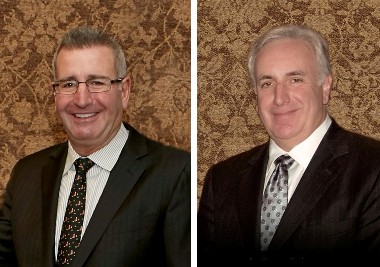
Couristan's Ron Couri, president and CEO, and George Couri, chairman and COO, reflect on the company's long history, and talk with RugNews.com about the future.
|
ATLANTA--It has been 90 years since Couristan was founded by brothers Basil and George Couri, and partner, David Murad. The company kicked off the milestone at the Atlanta International Rug Market on Thursday, Jan. 14 with a 90th anniversary party replete with a Roaring Twenties theme, American jazz and 26 percent off on pricing (in honor of its birthday in 1926).
In an exclusive interview with RugNews.com, Ron Couri, president, and George Couri, chairman, reflect on Couristan's 90-year staying power. They also discuss the unexpected boom in the outdoor rug business, Couristan's edge in the hospitality segment, its strategy for broadloom, and their outlook for the rug industry as a whole.
How did Couristan get its start?
Ron Couri: When the company was founded, it was Basil, George and David. They went over to Persia and brought back a consignment of rugs, and that's pretty much what started them in the rug business. We have a photo of our office that must have been taken around 1926, when we were founded, which we run periodically in our company newspaper, the Couristan Courier.
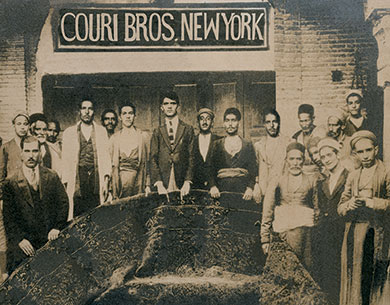 A 1926 photo of Couri Bros., New York, which began with a consignment of Persian rugs.
A 1926 photo of Couri Bros., New York, which began with a consignment of Persian rugs.
What do you think your father would say today about the company he started 90 years ago?
RC: I think he'd be very proud. When George and I came into the company, we started doing more in a month than the business had been doing in a year, and that's continued.
With Ron as president/CEO and George as chairman/COO, the company structure seems to be divided into rugs and broadloom. Is that fairly new?
George Couri: It really isn't that much different from Couristan's early structure. My father was always more involved in the broadloom side and Basil focused more on rugs. Now I run the residential broadloom and hospitality divisions, and Ron runs the area rug business.
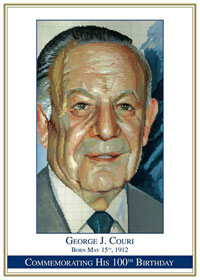 |
A commemorative portrait of George J. Couri, a founder of Couristan and father of the present owners, Ron and George Couri.
|
Who had the idea of manufacturing your own broadloom carpeting?
GC: My father had the idea. We were importers at the time--this goes back to the mid-70s. The people we were importing from - one was in England and two were in Ireland - both [companies] went into liquidation so we bought them. When my father was alive, we kept production in the U.K. and imported from those companies. But in 2006 we moved their equipment to China and Thailand.
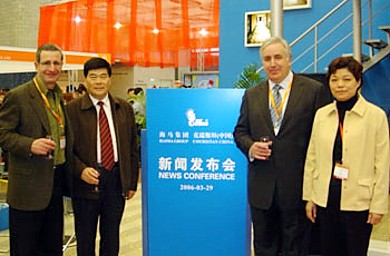 Ron and George Couri of Couristan in China at a 2006 news conference announcing the joint venture between Couristan and Haima Group to form Couristan/China.
Ron and George Couri of Couristan in China at a 2006 news conference announcing the joint venture between Couristan and Haima Group to form Couristan/China.
You manufacture all over the world. How did that come about?
RC: When the company first started in the 1920s, it was a direct importer selling wholesale.
In the '30s, we had a big hooked rug business coming out of China. And then after the Revolution, we moved that to Taiwan. When China opened up again in the '60s, when Mao took over, we were one of the few companies invited back. I made my first trip to China in 1975.
What do you see as Couristan's biggest opportunities for growth?
GC: The outdoor market and hospitality are big growth areas.
Weren't you a pioneer in the indoor-outdoor business?
RC: Yes, we started it in 2001. Actually, going into the polypropylene business, which we probably began 20 years ago, gave rise to the indoor-outdoor rug business that we started in 2001. We have probably had seven generations of indoor-outdoor rugs. I'm sure some of them are used indoors, but they're designed for use outdoors. You can just hose them down and let them dry off. Outdoor has been a very big growth area--not only for our business, but for the industry in general.
Couristan, a pioneer in outdoor rugs, launched the Recife collection in 2003. Power-loomed of 100 percent Courtron polypropylene, the groundbreaking line is UV stabilized, and mold and mildew resistant.
HOSPITALITY, BROADLOOM & UNEXPECTED SURPRISES
What is your competitive edge in hospitality?
GC: We manufacture our own product. We own our own looms, which we had moved in 2006 from England and Ireland to China, Thailand and Poland. And we have about 20 designers on staff in the U.S. who work hand in hand with the hotels, country clubs, lodges and restaurants.
We have offices around the country--the offices are tied in to the areas where the specifying is done for these hotels. For example, we have an office outside of Washington for Marriott, and an office in Los Angeles for the Vegas work. Our design staff is spread across the country.
Hospitality is mostly broadloom, Axminster broadloom, so we still maintain an office in the UK and in St. Helen's. Basically after the job is specified, we turn it over to the UK and they then give it out to our factories in China, or Thailand, depending upon pricing and how much time we have. We have what we call a "fast track," where if a client needs new carpet in a hurry; we might give it to Poland. They're a little more expensive but they have the time to produce a fast track order. If it's a hotel that's going up in Macao, we'll probably do that out of China.
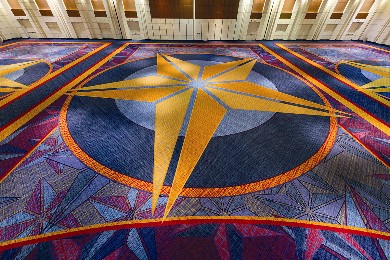
A commercial broadloom installation at the Fort Worth Convention Center shows Couristan's custom capabilities.
Why is your production in China different from that of other hospitality carpet made there?
GC: The difference is they use Chinese wool; we use a blend of 80 percent New Zealand wool and 20 percent nylon for durability. Our carpet a) is branded, and b) it holds up and won't fuzz.
What about residential broadloom--where is that made?
RC: For our residential division, which is area rugs and wall-to-wall carpet, we basically import from all over the world. In those categories, we're very big out of Belgium, Turkey, Spain, China, India, and Pakistan.
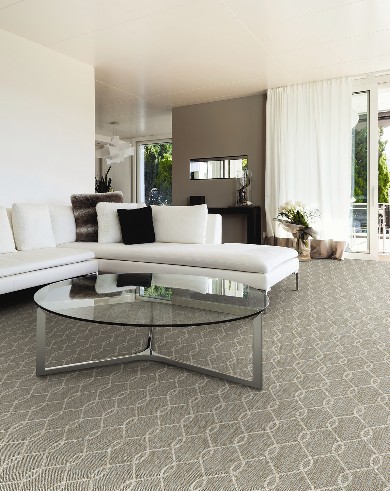 A woven Wilton loop pile residential broadloom product, Paloma features a 100 percent pure wool surface pile and is available in five colors.
A woven Wilton loop pile residential broadloom product, Paloma features a 100 percent pure wool surface pile and is available in five colors.
What fibers do you use for area rugs?
RC: We have 100 percent wool machine-made rugs, and tufted rugs out of India, knotted rugs that are 100 percent wool, and then we have rugs that are made out of polypropylene, which is about 25 percent of the cost [of wool] and virtually indestructible. It's obviously not the same as wool but the average consumer really doesn't care. Rugs used to retail at an average price of $1,000. Now the average is $399.
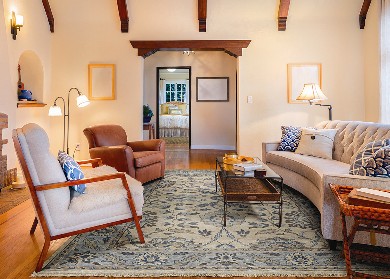 With the Tenali collection, Couristan gives traditional designs a modern twist. The line is hand knotted of 100 percent New Zealand wool with a washed finish.
With the Tenali collection, Couristan gives traditional designs a modern twist. The line is hand knotted of 100 percent New Zealand wool with a washed finish.THE FUTURE IS HERE
What about industry changes in the next decade or so?
RC: I expect the industry to shrink, because there is an oversupply of rugs. The bricks and mortar side has already seen a lot of consolidation. In the old days, you used to have so many more mom-and-pop stores. In Chicago, you had Pedian; in New York, you had Einstein-Moomjy. These retailers no longer exist. The business is pretty much dominated by the big boxes, the Home Goods-type stores: I think Home Depot's No. 1, followed by Home Goods.
And e-commerce has obviously changed a lot of the business. It's amazing how much. On Cyber Weekend, for example, we shipped over 2,000 rugs (sold by retailers, but drop shipped to the consumer). Look at [online] retailers like Wayfair that's going to do over a billion dollars this year. We're a big chunk of their rug business. Consumers are more comfortable buying high ticket items without actually seeing them in a store. Frontgate is selling $35,000 barbecue grills through its catalog.
GC: The rug industry has changed a lot. We've had to diversify to adapt to the changes. Hospitality really hasn't changed that much. Except that now there are a lot of low-grade manufacturers from China, who appeal to people who just want to buy price, and don't care that the carpet is going to fall apart in three years. We set ourselves apart from that, and go for quality. It's the same with area rugs and residential broadloom. Our residential broadloom starts at a moderate price point, but we have goods that are over $100 a yard wholesale, so it's $200 a yard retail.
What have been your biggest surprises over the years?
RC: I think the growth of the outdoor business was a big surprise. When we introduced it in 2001, I gave it three to five years. Fifteen years later, it's still double-digit growth every year with new constructions, new looks, etc. That's been a big surprise.
GC: And if you saw the designs we do for some of the major hotel chains, they're surprisingly beautiful. We have some very talented people..
Are you hoping to pass the legacy on to the next generation?
RC: We do want a legacy. My oldest son, Evan, who's 31 works in marketing here, and I'm sure George, whose children are much younger, will want them to carry on the legacy when they get old enough. We're celebrating 90 years, and I'm sure we'll have 90 more.
What's next for Couristan, looking ahead to the next decade?
GC: We will continue innovating, growing, developing and looking forward to our 100th.
At the January 2016 Atlanta International Rug Market, president Ron Couri shows off a rug from Kashimar, Couristan's first power-loomed rug collection recreating hand-knotted Persian and Oriental wool carpets at a fraction of their cost.